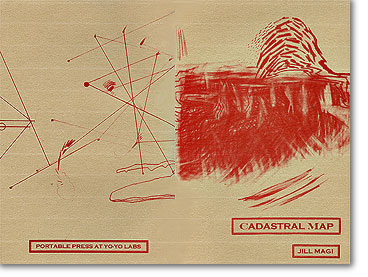Jill Magi
2005
$6.50 ppd.
Sold Out
| ||||||||||
 |
Cadastral Map
Jill Magi Sold Out |
| BIO:
shadow cast by text
Magi prescribes a text that is not merely a flat, oblivious mechanism of conveyance. The text itself has agency. It stands as a solid presence, like a tree or mountain, capable of blocking light and paving roads. She carries this text, fragmented and somewhat daunting, into the rest of the chapbook. This is essential for Magi’s project, which is driven by her concern that nature writing has become a genre of ineffectual and homogenous propaganda rooted in the accepted tradition of destruction. It is from this tradition of destruction that Magi is able to ask, “What is Missing in the / Picture?” Again, like Howe, she is interested in uncovering what has been marginalized or excluded from the tradition. It is the landscape of the “whole world lying outside” that Magi is working to reconcile. or shadow-text come to light pushing our paved roads through the last silence then What is Missing in the Picture? A whole world lying outside the brackets returns to haunt the narrowed page This particular sequence of poems is most interesting when it explores and delineates the connection between commodity, text, and nature. The title Cadastral Map serves as a significant tool of contextualization, placing the reader immediately in a place where landscape and commodity are intimately connected. As defined by Magi, a cadastral map is “drawn as if from an aerial view, composed by surveyors to determine land ownership for the purpose of taxation,” and it does not take into consideration actual topography or social relationships between farmers. Commodity and appraisal are the key elements to the map. Lines like “learning to make / the Editor’s // of omission / among the trees & slips of // lawn” work well to tie in the role of text into this relationship—just as we appraise land and nature, we appraise language as having certain paradigmatic value. This is something an editor would judge and execute because their role is essentially to omit. Following these lines, we get a glimpse of Magi’s gift in imagery: “slender note / of a remembered / redbreast // its boards covered / in mottled brown paper // the sky spread over / half-moon the swallows // they garden the roses all / gently omitted.” The complexity of these images is astounding and fluid while her talent for blending landscape images is clear—as readers we are on the page, in nature, and in the world of commodity-through-exclusion all at the same time. Mackenzie Carignan is finished her PhD at the University of Illinois, Chicago, in creative writing. her poetry has been published in Hayden’s Ferry Review, Bluesky Review, and The Chaffin Journal among other journals. She lives in Chicago with her husband Brian and young son Eliot. | |